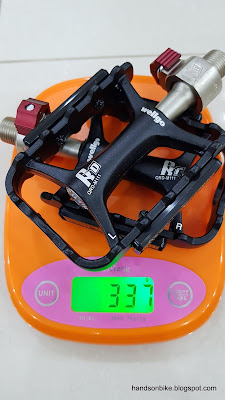First, let's choose the seatpost for the Crius bike. A seatpost's main purpose is to support the saddle, therefore it needs to be strong enough. It is also one of the easiest places to save weight, if you use a Litepro seatpost that is both lightweight and strong.
Stock seatposts are rated for a maximum rider weight of around 105 kg, as that is the maximum that is safely allowable by the bike manufacturer. However, if the rider is not that heavy, we can change to a lighter seat post with a lower maximum weight limit.
Litepro A61 aluminium seatpost is lightweight and strong
Maximum allowable weight is 80 kg, which is due to the more lightweight construction.
Minimalist saddle clamp design to reduce weight
The support plate for the saddle rail has been improved from the previous version, with a longer support area to minimize the bending of the saddle rails.
376 grams for the Litepro seatpost. Slight weight increase from previous versions.
As for the choice of saddle, I will not know what works best, as everyone has a different butt shape that will prefer different saddle shapes. What I can do is to choose a cheap saddle of decent quality, so that it is a good start. If the rider finds a more comfortable saddle, he or she can change it out without hesitation as the original saddle is not that expensive anyway.
From my experience on the Avanti Inc 3, the Selle Italia Q Bik saddle is cheap (around $30) and is quite comfortable, although it is not that lightweight. Basically it is a good saddle to get you started so that you can ride the bike.
Good and affordable Selle Italia Q Bik saddle
This is the model of the saddle
Decent design and appearance
Good workmanship, without unsightly folds or staples visible.
Standard steel saddle rail (FeC = Iron + Carbon Alloy = Steel?)
273 grams, which is a decent weight for a cheap and comfortable saddle.
Finally, the choice of pedals. What is required is just a pair of smooth rolling metal pedals that have a comfortable platform for pedaling. Plastic pedals are not recommended as they are prone to breaking under higher loads.
As a folding bike, it will be better to have folding or detachable pedals as it can reduce the folded size. Folding pedals such as the MKS FD-6 (now FD-7 I think) are compact, but the grip is not sufficient, while it is also heavy.
I decided to get detachable pedals, as the grip is better, while also being of lighter weight and is also slightly cheaper.
Wellgo M111 detachable pedals
Model number M111 printed here
Quick release mechanism links the crankarm to the pedal axle. Different from the MKS mechanism that I am using on the Brompton.
Another view of the quick release mechanism
Instructions here. Pull up the red cap to release or insert the pedals to the mechanism.
As seen here, pulling the red cap will release the pin that allows the pedal axle to be inserted or removed.
Hexagonal profile aligns to the mechanism, while the undercut area is locked when you release the red cap.
Decent looking profile that should give a decent grip on any rubber soled shoe.
Contact rubber seal on the pedal axle, to minimize the intrusion of dust and dirt, while keeping in the grease. Not the best seal design as it is quite exposed.
A pair weighs 337 grams including the mounts, which is quite good. Lighter than the MKS Promenade EZY pedals on the Brompton.
Comes with a few thin washers, to be used between the crankarm and the mount.
Purpose of these thin washers is to allow adjustment of the mount angle, as the red cap can be pointed anywhere depending on where the pedal thread starts.
Using two thin washers, I was able to position the red cap exactly within the crankarm when tightened, which is the neatest position.
However, on the left side, no matter I use zero, one or two thin washers, I was not able to place the red cap within the crank arm. This was the best orientation that I could get.
As you can see here, the problem with having a preferred orientation on a rotational part is a problem, as you will not always be able to align it properly. It does not affect the quick release function or the pedaling, just that it does not look so neat.

























No comments:
Post a Comment
Every comment is moderated before publishing due to spam bots. If you don't see your comment yet, it is likely that it is currently being reviewed. Thank you for your patience!